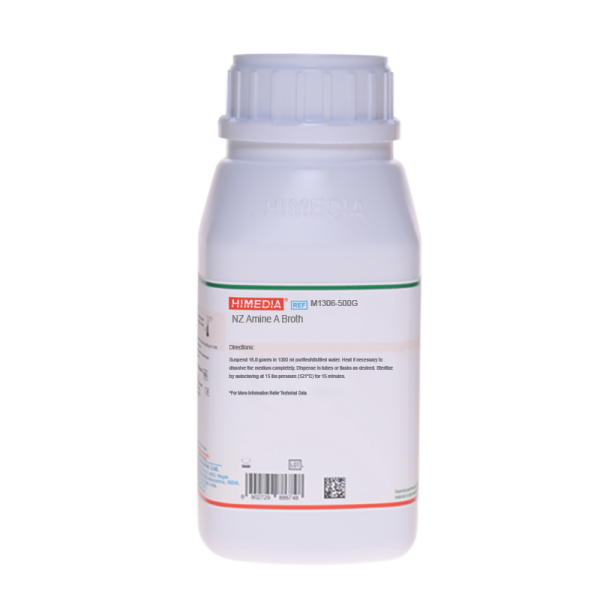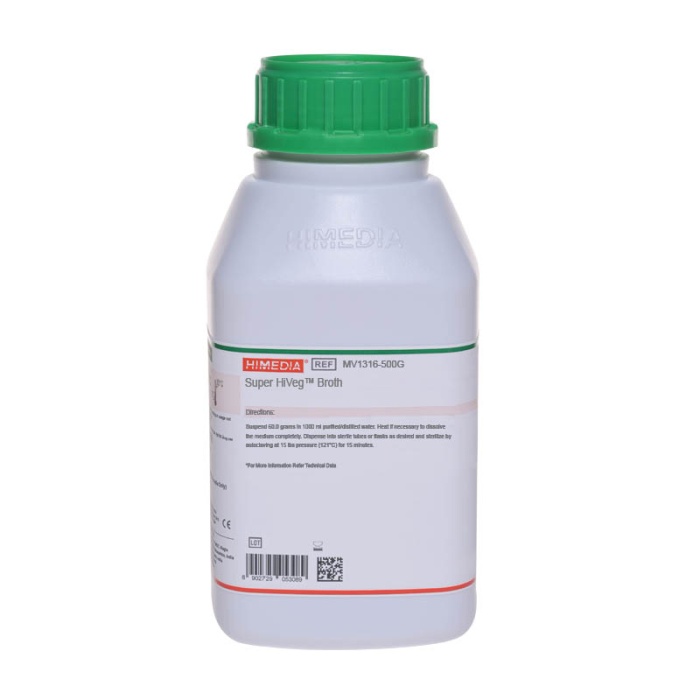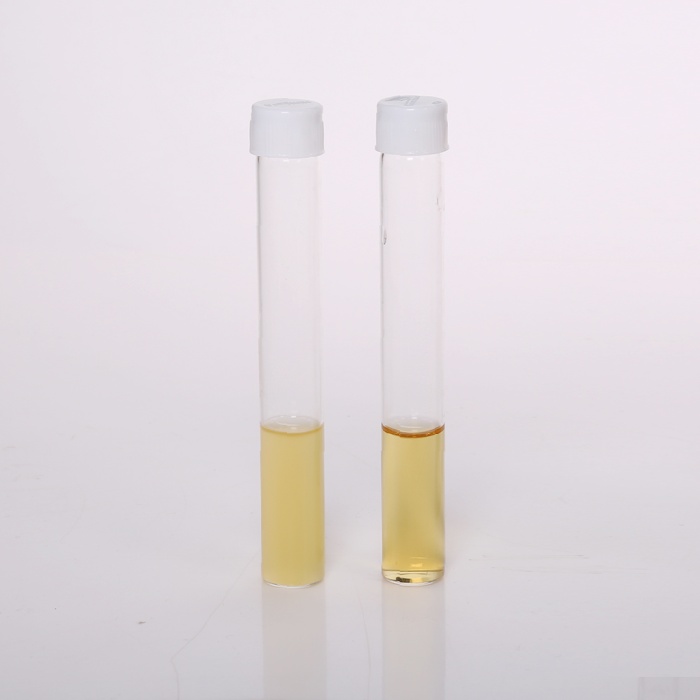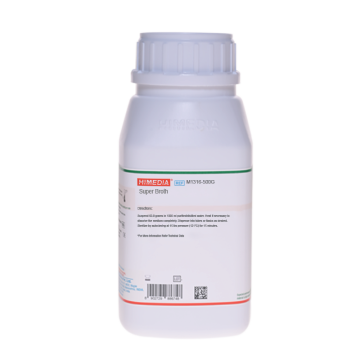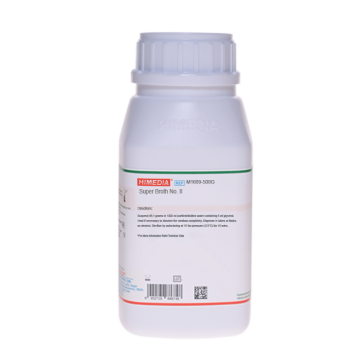 Your enquiry has been submitted
Your enquiry has been submitted
NZ Amine A Broth
Intended Use:
Recommended for the cultivation of Escherichia coli.
Composition**
| Ingredients | Gms / Litre |
|---|---|
| Acicase™ # | 1.000 |
| NZ Amine A | 10.000 |
| Sodium chloride | 5.000 |
| Magnesium chloride | 2.000 |
**Formula adjusted, standardized to suit performance parameters
# Equivalent to Casein acid hydrolysate
Directions
Suspend 18 grams in 1000 ml purified/distilled water. Heat if necessary to dissolve the medium completely. Dispense in tubes or flasks as desired. Sterilize by autoclaving at 15 lbs pressure (121°C) for 15 minutes.
Principle And Interpretation
Escherichia coli is commonly used as a model organism for bacteria in general. Because of its ubiquity, E. coli is frequently studied in microbiology and is the current “workhorse" in molecular biology. E. coli plays an important role in modern biological engineering. Researchers can alter the bacteria to serve as "factories" to synthesize DNA and/or proteins, which can then be produced in large quantities using the industrial fermentation processes. One of the first useful applications of recombinant DNA technology was the manipulation of E. coli to produce human insulin for patients with diabetes. E. coli grow rapidly in NZ Amine A Broth (2) as it provides necessary metabolites for the cell, which would otherwise have to be synthesized by the cell (3).
Acicase™ and NZ Amine A provide necessary nutrients and cofactors required for the growth of E. coli. Sodium chloride helps to maintain the osmotic balance whereas magnesium ions serves as immediate activator required for a number of enzymatic reactions, including DNA replication of the cell.
Type of specimen
Food and dairy samples; Water samples
Specimen Collection and Handling:
For food and dairy samples, follow appropriate techniques for sample collection and processing as per guidelines (1,7,8). For water samples, follow appropriate techniques for sample collection, processing as per guidelines and local standards (4). After use, contaminated materials must be sterilized by autoclaving before discarding.
Warning and Precautions
Read the label before opening the container. Wear protective gloves/protective clothing/eye protection/face protection. Follow good microbiological lab practices while handling specimens and culture. Standard precautions as per established guidelines should be followed while handling specimens. Safety guidelines may be referred in individual safety data sheets.
Limitations
- Further biochemical and serological tests must be carried out for complete identification.
- Individual organisms differ in their growth requirement and may show variable growth patterns on the medium.
Performance and Evaluation
Performance of the medium is expected when used as per the direction on the label within the expiry period when stored at recommended temperature.
Quality Control
Appearance Cream to yellow homogeneous free flowing powder
Colour and Clarity of Prepared medium
Cultural Response
Light to medium amber coloured clear to slightly opalescent solution
Cultural characteristics observed after an incubation at 35-37°C for 18-24 hours.
| Organism | Inoculum (CFU) | Growth |
|---|---|---|
| Escherichia coli ATCC 23724 | 50-100 | good-luxuriant |
| Escherichia coli ATCC 53868 | 50-100 | good-luxuriant |
Storage and Shelf Life
Store between 10-30°C in a tightly closed container and the prepared medium at 15-25°C. Use before expiry date on the label. On opening, product should be properly stored dry, after tightly capping the bottle in order to prevent lump formation due to the hygroscopic nature of the product. Improper storage of the product may lead to lump formation. Store in dry ventilated area protected from extremes of temperature and sources of ignition. Seal the container tightly after use. Product performance is best if used within stated expiry period.
Disposal
User must ensure safe disposal by autoclaving and/or incineration of used or unusable preparations of this product. Follow established laboratory procedures in disposing of infectious materials and material that comes into contact with sample must be decontaminated and disposed of in accordance with current laboratory techniques (5,6).
Reference
- American Public Health Association, Standard Methods for the Examination of Dairy Products, 1978, 14th Ed., Washington D.C.
- Atlas R. M., 2004, Handbook of Microbiological Media, Lawrence C. Parks (Ed.), 3rd Edition, CRC Press, Boca Raton.
- Ausubel F. M. et al, 1994, Current Protocols in Molecular Biology, Vol. 1, Current Protocols, New York, NY.
- Baird R.B., Eaton A.D., and Rice E.W., (Eds.), 2015, Standard Methods for the Examination of Water and Wastewater, 23rd ed., APHA, Washington, D.C.
- Isenberg, H.D. Clinical Microbiology Procedures Handbook 2nd Edition.
- Jorgensen, J.H., Pfaller, M.A., Carroll, K.C., Funke, G., Landry, M.L., Richter, S.S and Warnock., D.W. (2015) Manual of Clinical Microbiology, 11th Edition. Vol. 1.
- Salfinger Y., and Tortorello M.L., 2015, Compendium of Methods for the Microbiological Examination of Foods, 5th Ed., American Public Health Association, Washington, D.C.
- Wehr H. M. and Frank J. H., 2004, Standard Methods for the Microbiological Examination of Dairy Products, 17th Ed., APHA Inc., Washington, D.C.
| Product Name | NZ Amine A Broth |
|---|---|
| SKU | M1306 |
| Product Type | Regular |
| Physical Form | Powder |
| Origin | Animal |
| Packaging type | HDPE |
| References | 1. Atlas R. M., 2004, Handbook of Microbiological Media, Lawrence C. Parks (Ed.), 3rd Edition, CRC Press, Boca Raton. |
| Customized Product Available | No |



